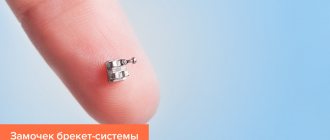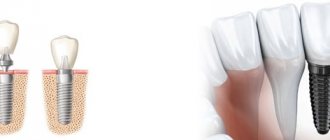Reading time 7-8 minutes
Author of the article: Tsurkan Victoria Olegovna
Specialization: Dentist-orthodontist
Total work experience: since 2015
- Stages of defect correction and expected results
- How long should you wear traction braces?
- Brief summary
When deciding on the use of orthodontic structures, patients are often interested in how long they wear braces on their teeth. Since the timing is determined individually, it is important to answer the question of what affects the duration of wear and what results to expect during the treatment process and after its completion.
People around you start to envy you kindly
Not many people can boast of a perfect smile, but only a few take on this problem. However, braces on an adult are causing others to think about going to the dentist again. Yes, people around you will pay attention to you more often; friends and acquaintances will begin to be interested in the details of the treatment, the sensations, and the cost of the design. One thing is for sure - they will respect you, because you care about your health and did what many do not dare to do. In addition, not everyone is ready to shell out more than 100 thousand rubles to correct their smile.
What do the doctor's say?
Orthodontists say that the age from 15 to 20 years is the most favorable for straightening teeth and correcting bite. It is during this period that the jaw tissue is most “pliable”; the process of orthodontic treatment is completed successfully in almost all cases.
If you take up this issue at an older age, the tactics for correcting the bite have significant differences:
- The duration of therapy is at least three years.
- To begin aligning the units, you may first need to remove any teeth in the mouth that may prevent the teeth from moving into the correct position.
- If the condition was deplorable before treatment, the specialist may recommend wearing retainers for life. They are completely invisible in the mouth, so many patients do not see this as a problem.
In general, experts do not see anything wrong with starting to correct the bite after 35 years. If you do nothing, this is fraught with the following complications:
- In the future, teeth will begin to decay much earlier than expected.
- Increased wear of the enamel may occur.
- The risk of dental diseases increases, ranging from caries to periodontitis or periodontal disease.
- The face becomes asymmetrical.
- Incorrect bite also affects diction.
Reaching a new goal
Perhaps you are faced with a difficult choice: on the one hand, you are embarrassed about your smile, on the other, you do not want to wear braces for 1 to 3 years. But the faster you start, the faster you finish. As they say, the best time to do this is yesterday, the second best time is today. Moreover, you will experience great joy as you systematically move towards your goal, seeing how your teeth are straightened month after month, and in the end you will get the long-awaited result - a beautiful smile. This experience will certainly be useful in other areas of life.
At what age is it easiest and fastest to get the desired result?
As a rule, an orthodontist will recommend putting braces on a child at the age of 10–12 years, when the formation of the maxillofacial apparatus is completed and the body is in the stage of active growth. But quite often doctors have to carry out corrections for preschoolers using removable orthodontic structures or postpone treatment with braces until they reach 16–18 years of age.
- Faster results of correction in adolescence are explained by greater compliance of the jaw bone.
- In children with baby teeth, the desired result can often be achieved by wearing a removable mouthguard or trainer. In adults, the same devices cope with only the most minor anomalies.
- Moreover, children whose jaw is just developing benefit from massage and specialized gymnastics that train the muscles of the face and tongue.
There are other features that significantly increase the cost and prolongation of orthodontic treatment for adults and even make it impossible.
Teeth don't move
Initially, incorrectly planned orthodontic treatment with braces sometimes leads to a dead end. The bracket system is exhausting its resource. The arcs take an even position and also stop working. However, the teeth are in an uneven position that does not suit the patient and the doctor. Additional efforts do not lead to the desired result. Natural questions arise for the attending physician. Mutual claims and excuses. In general, an unpleasant situation. This is due to initially incorrectly planned orthodontic treatment. Inaccurate calculation. Ignoring the fundamental rules of the protocol for fixing the bracket system and diagnostics before starting to correct the bite with braces. Perhaps the inexperience of the attending physician, or the so-called human factor. Recently I was contacted by a patient who has been undergoing treatment with braces for about 10 years! Sometimes it happens. There is no need to panic and ring the bells. Almost any movement of teeth in the mouth is reversible as long as the teeth have strong roots, and the orthodontist understands the essence of the treatment and knows what he is doing. There are many ways to correct the situation. For example, bending an arc. The orthodontist, understanding the essence of the problem, bends the arch, thereby forcing the arch to work in the desired direction.
In the arsenal of a professional orthodontist there are many methods, devices and devices for moving teeth, but despite all this, there are reasons and situations in which the braces system cannot help. Ankylosis of the tooth. One of the most common dental anomalies. For one reason or another, the tooth loses its periodontal ligaments, which make movement possible. The tooth is firmly fused with the bone and its movement becomes impossible. Such a tooth, as a rule, is underdeveloped and has a smaller height in relation to the dentition. Often has a different inclination in the dentition. When tapped, it makes a muffled sound. An ankylosed tooth requires therapeutic and orthopedic intervention to return it to bite. As an option, creating an artificial crown. It is possible to camouflage the tooth with veneers, lumineers or aesthetic restoration, according to indications.
And in conclusion, let me once again remind you of the importance and necessity of preliminary diagnosis, analysis of OPTG or CBCT images, casts and, if necessary, more complex studies before correcting the bite with braces. Competent and accurate diagnosis is the key to the success of orthodontic treatment. Take your time when starting orthodontic treatment, weigh everything and find out more information. Get advice, get advice and be healthy!
How much do braces cost?
Indeed, dental correction cannot be called very affordable. However, we are doing everything to provide this opportunity to those who need it. With us you can get comfortable installments and choose a system from different price segments. Sometimes it is advisable to choose more expensive braces for one jaw and install a cheaper design on the other.
In the price list you will find a complete list of designs. But it’s better to talk about this with your doctor - he will tell you what is right for you, how long you will need to wear braces and how much you will have to spend on it. For example, the most technologically advanced Damon self-ligating braces, which reduce treatment time by 20–30%, cost a little more.
It is worth understanding that the total cost of treatment includes regular visits to the doctor, professional cleaning, replacement of locks and other issues.
Remember - any doubt can be resolved in consultation with a doctor!
We start with the upper front teeth
On the upper front teeth, all the composite and all the material from the teeth were almost completely removed. On the fours and fives on top we only had roots. The front teeth were also not distinguished by the presence of large tissues; we also only had roots. Except for tooth 2.2, tooth 2.2 was alive. That is, of the top 10 teeth with which we worked, only 3 teeth were alive, and 7 were previously depulped.
It turns out we had 4 chewing teeth of which only the root remained, and all the composite fillings were removed from the 3 front teeth; they went almost to the root.
We slightly drilled the root canal
in order to install single-module veneers with the root part.
See what veneers look like with the root
:
Features of treating crooked teeth for veneers in the lower jaw
By the time the lower teeth were turned, we had already prepared a project, which I relied on - we displayed it on a huge 43-inch monitor. We did something incredible. Taking into account gum correction (the gum was corrected at tooth 1.1)
Below was a very complex project. After we sharpened we received photographs and a real view of the lower teeth
:
Once trimmed, it looked incredible. It felt like the teeth were completely straight from the start.
Despite the fact that the lower teeth were actually very crooked, we were able to build the ideal geometry of the dentition. Some teeth, such as 3.1, we “pushed” inward a little, and then did the same with teeth 4.1, 4.3 and 3.3.
We filed down the central lower teeth very much from the inside ( BUT!
We didn’t reach the nerve). We “moved” teeth 3.2 and 4.2 outward, filing down their inner part. As a result, as I said earlier, we did not depulpate a single tooth.
The teeth from below, from fang to fang, look quite even, that is, we managed to reach an even plane, an even line. Since we ground teeth 3.2 and 4.2 both inside and out, we decided to make practically crowns on them, that is, the contact points between the teeth remained intact, and the front and back parts were ground as if for a crown.
Contraindications
For Patients over thirty years of age, braces cannot always be placed; there are a number of absolute contraindications:
- malignant neoplasms;
- diabetes of any type;
- problems with immunity, HIV;
- mental disorders, nervous system;
- periodontal disease;
- pathology of bone tissue;
- edentia, in which a large number of teeth are missing;
- blood diseases, poor clotting;
- tuberculosis.
Relative contraindications that must be eliminated before installing the structure include:
- arthritis affecting the TMJ;
- hormonal disorders;
- poor oral hygiene;
- presence of prostheses or implants;
- endocarditis and others.
Before starting therapy, the doctor must conduct a diagnosis. This allows you to identify contraindications, obtain data for choosing a device and drawing up a correction scheme.
Wearing design.
After adaptation, the painful sensations disappear, the teenager gets used to the system in the oral cavity, and it no longer causes negative emotions. The mucous membrane experiences temporary discomfort if the protruding parts of the structure begin to rub. It can also be difficult for a child to chew solid food, so dentists advise avoiding it.
Long-term wearing of braces is necessarily accompanied by scheduled visits to the orthodontist, during which the doctor changes ligatures and metal arches. Replacement provokes a new round of unpleasant sensations, as the teeth are again subjected to certain loads. But, according to reviews from the patients themselves, pain at this stage is no longer present or minimal.
Rodikova Tatyana
“I recommend self-ligating braces to my patients - without rubber bands. Teenagers like the fact that they can go to appointments less often, as well as the more aesthetic appearance of the system. In addition, adaptation to such braces takes less time - pain is minimal and goes away in 3-5 days.”
How to wear and care for braces?
For those who have made the right choice and decided to correct their teeth, the doctor will give personal recommendations on how to care for the oral cavity during treatment.
The main recommendation would be proper hygiene and reasonable dietary restrictions. For example, when treating a malocclusion, you should refrain from sharp temperatures of food and drinks, and exclude very hot and very cold foods. You should also not gnaw on fruits and vegetables or crack nuts - all this can move the locks and damage the structure. If there is any violation of the position of the braces, you will need to consult a doctor for correction.
Braces place responsibility on the patient. The duration of treatment and the condition of your teeth after removing the braces system depend on how well you observe hygiene and rules. As for brushing your teeth at home, it will take a little longer. It is necessary to use special devices to clean the enamel around the locks after each meal. In addition, the orthodontist prescribes professional cleaning in the clinic to all patients at the required frequency. This way you will protect your teeth from caries, because the risk increases if you do not pay due attention to hygiene. In general, oral care tips will be quite simple. All patients quickly get used to the new rules and even stop noticing that they spend 5-10 minutes more on dental care.
Next, we will answer the last, but very popular question: how much do braces cost? In our clinic, patients have a fairly large selection of systems from different manufacturers. The cost of treatment depends on the materials and type of structure, as well as the timing of wearing braces.
How do braces work?
Naturally, the doctor works with each patient individually. There are many types of braces, as well as many types of malocclusions. Already during the consultation, it becomes clear what problem is relevant and how to solve it.
How do braces work? After choosing a design, the doctor will carefully place the lock in the desired position on each tooth. Here it is important to take into account not only the position of individual teeth, but also the condition of the entire row. After all, even a small change in the position of one element leads to a displacement of all the others. Therefore, it is extremely important to configure everything correctly.
During treatment, the patient must regularly visit the doctor for preventive and corrective examinations. As the correction progresses, the doctor will gradually move the braces, adapting them to the new position of the teeth.
How long should you wear braces?
Another common fear of patients is always the duration of treatment. Despite all the promises of doctors and the testimony of other patients that the installation of the structure has practically no effect on the usual rhythm of life, it is always difficult to decide to correct teeth. It seems like I'll have to wear braces forever!
How long do you really need to wear braces? We have already said that in childhood, treatment is faster due to the characteristics of bone tissue, which is still pliable and ready for rapid changes. Therefore, for children, the period of wearing structures is about 6–12 months, and in complex cases or adolescence it can increase to 1.5 years.
For people 20–30 years and older, the average treatment period is 2 years. The teeth are already firmly fixed in their position, and it will be more difficult to move them from their place.
Don't forget that in dentistry everything is very individual. Your case may be exceptional and require unusual deadlines. It is also possible that the bite will correct itself faster than expected. For example, if self-ligating braces are used. The main thing is not to forget to visit the doctor strictly in accordance with his recommendations, so as not to miss the opportunity to shorten the treatment period.
What are braces and who are they for?
We have known about braces for quite a long time - both in life and in movies we have seen people with characteristic braces on their teeth. Essentially, braces consist of small clasps glued to the teeth with special dental glue, and a metal arch passing through them, connecting them into a single system.
The archwire transfers pressure to the teeth, which causes the misaligned teeth to gradually shift toward a more correct position. As the defects are corrected, the arch must be tightened: for this, the patient needs to visit the dentist once every 2 weeks, and after treatment is completed, he also needs to wear special retainers that will prevent the possibility of reverse displacement of the straightened teeth.
At the same time, there is another method - the use of aligners. What is the difference between braces and aligners? Aligners are transparent aligners made of special plastic that fit tightly onto the teeth and create the necessary pressure to correct misaligned teeth. Speaking about the difference between braces and aligners, it can be noted that braces create many inconveniences in everyday life: they are clearly visible from the outside, they must be thoroughly cleaned after every meal, they are difficult to get used to and serious dietary restrictions must be observed during the period. wearing them.
However, in case of serious malocclusion, it is necessary to wear braces. In addition, aligners are usually used only for adults who have completed their period of jaw growth, although aligners are now being developed for children over 7 years of age. Braces do not have such a limitation - they can be placed on children at almost any age.
In addition, there is a difference between braces and aligners in the force of impact: braces are a more rigid structure that puts more pressure on the teeth, so they can be used to correct more complex situations.
Braces or aligners? No, veneers!
After conducting digital diagnostics, I eventually told her that it was theoretically possible to install veneers while maintaining a normal bite. Everything can be done provided that your joint does not hurt, nothing crunches, everything is comfortable for you and absolutely nothing bothers you.
And we decided to try to make her a digital project, in which we will see if we can install veneers with such crooked teeth. That is, can we do the work on the veneers, place them evenly enough so that she likes it?
Also in the project you can see some footage where the doctor understood how much the lower teeth needed to be ground down in order to get an even lower dentition, that is, how much each tooth needed to be ground down minimally in order to get an even dentition.
Why was it necessary to sharpen the teeth as little as possible?
So as not to reach the nerve. Because when we carried out the work, we almost reached the nerve, but even in such a serious crooked situation with the teeth (they were looking in different directions), we did not depulpate a single tooth and received an absolutely even dentition.
We made casts and a photographic protocol. I initially saw that the teeth were as crooked as possible, but I always knew that no matter what “crooked” situation we found ourselves in, everything always turned out smooth. In Maria’s situation, my experience told me that it would turn out quite smoothly and nothing should bother her, taking into account the fact that we will be covering 20 teeth with veneers - 10 on top
and
10 from below
.











